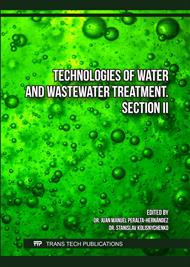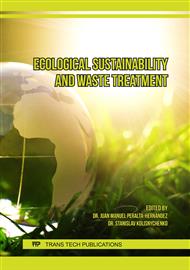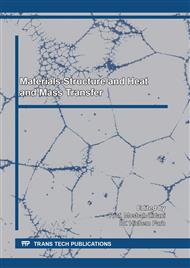[1]
A. Bogusz, P. Oleszczuk and R. Dobrowlski, Application of laboratory prepared and commercially availabla biochars to adsorption of cadmium, copper and zinc ions frow water,, Bioresource Technology, p.196, 540-549.
DOI: 10.1016/j.biortech.2015.08.006
Google Scholar
[2]
V. Taty-Costodess, H. Fauduet, C. Porte and A. Delacroixs, Removal of Cd(II) and P(II) ions from aqueous solutions by adsorption onto sawdust of pinus sylvestris,, J Hazard Master, p.105 (1-3): 121-142, (2003).
DOI: 10.1016/j.jhazmat.2003.07.009
Google Scholar
[3]
F. Wang, Y. Pan, P. Cai, T. Guo and H. Xiao, Single and binary adsorption of heavy metal ions from aqueous solutions using sugarcane cellulose-based adsorbent,, Bioresource Technology, p.241, 482-490.
DOI: 10.1016/j.biortech.2017.05.162
Google Scholar
[4]
S. Jiang, L. Huang, T. A. H. Nguyen, Y. S. Ok, V. Rudolph, H. Yang and D. Zhang, Copper and zinc adsorption by softwood and hardwood biochars under elevated sulphate-induced salinity and acidic pH conditions,, Chemosphere, p.142: 64-71, (2016).
DOI: 10.1016/j.chemosphere.2015.06.079
Google Scholar
[5]
L. Trakal, R. Šigut, H. Šillerová, D. Faturíkovaá and M. Komárek, Copper removal from aqueous solution using biochar: Effect of chemical activation,, Arab. J. Chem, p.7: 43-52, (2014).
DOI: 10.1016/j.arabjc.2013.08.001
Google Scholar
[6]
M. J. Kennish, Pratical Handbook of Estuarine and Marine Pollution, Boca Raton, FL, USA: CRC Press, (1996).
Google Scholar
[7]
A. W. Zularisam, A. F. Ismail and S. Razman, Behaviours of natural organic matter in membrane filtration sor surface water treatment - a review,, Desalination, p.194, 211-231, (2006).
DOI: 10.1016/j.desal.2005.10.030
Google Scholar
[8]
J.-H. Chang, A. V. Ellis, C.-Y. Yan and C.-T. Tung, The electrochemical phenomena and kinitics of EDTA- Copper wastewater reclamation by electrodeposition and ultasound,, Separationand Purification Technology, p.68, 216-221, (2009).
DOI: 10.1016/j.seppur.2009.05.014
Google Scholar
[9]
J. Youmi, Y. Yeojoon, H. Eunkyung, K. Minhwan and K. Joon-Wun, Inactivation characteristics of ozone and electrolysis process for ballast water treatment using B. subtilis spores as a probe,, Marine Pollution Bulletin, p.72, 71-79, (2013).
DOI: 10.1016/j.marpolbul.2013.04.028
Google Scholar
[10]
K. P. Lee, T. C. Arnot and T. Mattia, A review of reverse osmis membrane materials for desalinatin- Development to date and futur potential,, Journal of Membrane Science, p.370, 1-22, (2011).
DOI: 10.1016/j.memsci.2010.12.036
Google Scholar
[11]
S. De Gisi, G. Lofrano, M. Grassi and M. Notarnicola, Characteristics and adsorption capacities of low-cost sorbents for wastwater treatment: A review,, Sustainable Materials and Thecnologies, p.9, 10-40, (2016).
DOI: 10.1016/j.susmat.2016.06.002
Google Scholar
[12]
A. I. Ferraz, C. Amorium, T. Javares and J. A. Teixeria, Chormium (III) biosorption onto spent grains residual from brewing industry: equilibrium, kinetics and column studies,, Int. J. Environ. Sci. Techno, p.12, 1591-1602, (2015).
DOI: 10.1007/s13762-014-0539-6
Google Scholar
[13]
R. Torres-Caban, C. V. Vega-Olivencia, L. Alamo-Nole, D. Morales-Irizarry, F. Romman-Velazquez and N. Mina-Camilde, Removal of Copper from Water by Adsorption with Calcium-Algate/Spent-coffe-Grounds Composite Beads,, Materials, p.12, 395, (2019).
DOI: 10.3390/ma12030395
Google Scholar
[14]
Y. H. Li, B. Xia, Q. S. Zhao, F. Q. Lui and P. Zhang, Removal of copper ions from aqueous solution by calcium alginate immobilized kaolin,, J. Environ. Sci, p.23, 404-411, (2011).
DOI: 10.1016/s1001-0742(10)60442-1
Google Scholar
[15]
S. J. Chipera and D. L. Bish, BASELINE STUDIES OF THE CLAY MINERALS SOCIETY SOURCE CLAYS: POWDER X-RAY DIFFRACTION ANALYSES,, Clays and Clay Minerals, vol. 49, no. 5, pp.398-409, (2001).
DOI: 10.1346/ccmn.2001.0490507
Google Scholar
[16]
A. K. Panda, B. G. Mishra, D. K. Mishra and R. K. Singh, Effect of sulfuric acid treatment on the physico-chemical characteristics of kaolin clay,, Colloid and Surfaces A: Physicochem.Eng. Aspects, no. 363, pp.98-104, (2010).
DOI: 10.1016/j.colsurfa.2010.04.022
Google Scholar
[17]
J. Kristof, R. L. Frost, A. Felinger and J. Mink, FTIR spectroscopic study of intarcalated kaolinite,, Journal of Molecular Structure, no. 410-411, pp.119-122, (1997).
DOI: 10.1016/s0022-2860(96)09488-4
Google Scholar
[18]
J. Ikhsan, E. Widjajanti LFX and E. Priyambodo, The Adsorption of Cr3+ onto Na+ Saturated Kaolinite,, Advances in SocialScience, Education and Humanities Research , vol. 401, pp.295-298, (2019).
DOI: 10.2991/assehr.k.200204.056
Google Scholar
[19]
M. Tommes, K. Kaneko, A. V. A. V. Neimark and J. P. Olivier, Physisorption of gases, with special reference to the evaluation of surface area and pore size distribution (IUPAC Technical Report),, Pure and Applied Chemistry, vol. 87, no. 9-10, pp.1051-1069, (2015).
DOI: 10.1515/pac-2014-1117
Google Scholar
[20]
F. Hamadache, A. Chergui, F. Halet, A. R. Yeddou and B. Nadjemi, Copper, Zinc and Nickel's removal by bentonite clay: case study in mono and multicomponent systems,, Algerian Journal of Environmental Science and Technology, pp.2437-1114, (2019).
Google Scholar
[21]
R. Msaadi, G. Yilmaz, A. Allushi, S. Hamadi, S. Ammar, M. M. Chehimi and Y. Yagci, Highly Selective Copper Ion Imprited Clay/Polymer Nanocomposites Prepared by Visible Light Initiated Radical Photopolymerization,, Polymers, p.11, 286, (2019).
DOI: 10.3390/polym11020286
Google Scholar
[22]
S. V. Badmaeva, S. T. Khankhasaeva and E. T. Dashinamzhilova, Experimental Simulation of Sorption Processes of Heavy Metals on Natural Clay Minerals,, in IOP Conference Serie: Earth and Environmental Science, (2019).
DOI: 10.1088/1755-1315/272/3/032081
Google Scholar
[23]
J. T. Nwabanne and P. K. Igbokwe, The thermodynamic and kinetic behaviors of lead (II) adsorption on Activaed Carbon derived from Palmyra Plam Nut,, International Journal of Applied, pp. Vol,2 No.3, (2012).
Google Scholar
[24]
K. Huang, Y. Xia and H. Zhu, Removal of heavy metal ions from aquous solution by chemically modified mangosteen pericarp,, Desalin. Water Treat., p.52, 7108-7116, (2014).
DOI: 10.1080/19443994.2013.838522
Google Scholar
[25]
P. Pavasant, R. Apiratikul, V. Sungkhum, P. Suthiparinyanont, S. Wattanachira and T. F. Marhaba, Biosorption of Cu2+, Cd2+, Pb2+, and Zn2+ uzing dried marine green macroalga Caulerpa Lentillifera,, Bioresour Technol, p.97, 2321-2329, (2006).
DOI: 10.1016/j.biortech.2005.10.032
Google Scholar
[26]
A. T. Sdiri, T. Higashi and F. Jamoussi, Adsorption of copper and zinc onto natural clay in single and binary systems,, Int. J. Environ. Sci. Technol, p.11, 1081-1092, (2014).
DOI: 10.1007/s13762-013-0305-1
Google Scholar
[27]
K. Y. Foo and B. H. Hameed, Insights into the modeling of adsorption isotherm systems,, Chemical Engineering Journal, vol. 159, pp.2-10, (2010).
Google Scholar
[28]
N. Ayawei, A. N. Ebelegi and D. Wankasi, Modelling and Interpretation of Adsorption Isotherms,, Journal oh Chemistry, p.11, (2017).
DOI: 10.1155/2017/3039817
Google Scholar
[29]
D. Saha, N. Mirando and A. Levchenko, Liquid and vapor phase adsorption of BTX in lignin derived activated carbon: Equilibrium and kinetics study,, Journal of Cleaner Production, p.182, 372-378, (2018).
DOI: 10.1016/j.jclepro.2018.02.076
Google Scholar
[30]
Y. Ge, X. Cui, C. Liao and Z. Li, Facile fabrication of green geopolymer/alginate hybrid spheres for efficient removal of Cu(II) in water: batch and column studies,, Chemical Engineering Journal, vol. 311, pp.126-134, (2017).
DOI: 10.1016/j.cej.2016.11.079
Google Scholar
[31]
D. Allouss, Y. Essamlali, A. Chakir, S. Khadhar and M. Zahouily, Effective removal of Cu(II) from aqoueus solution over graphene oxide encapsulated carboxymethylcellulose-alginate hydrogel mocropheres: towards real wastewater treatment plants,, Environment Science and Pollution Rerearch, vol. 27, pp.7476-7492, (2019).
DOI: 10.1007/s11356-019-06950-w
Google Scholar
[32]
W. J. Weber and J. C. Morris, Kinetics of adsorption of carbon from solution,, J. San. En. Div., vol. 89, no. 1, pp.31-60, (1963).
Google Scholar
[33]
E. Igberase, A. Ofomaja and P. O. Osifo, Enhanced heavy metal ions adsorption by 4-aminobenzoic acid grafted on chitosan/ epichlorohydrin composite: Kinetics, isotherms, thermodynamicsand desorption studies,, International Journal of Biological Macromolecules, vol. 123, pp.664-676, (2019).
DOI: 10.1016/j.ijbiomac.2018.11.082
Google Scholar




